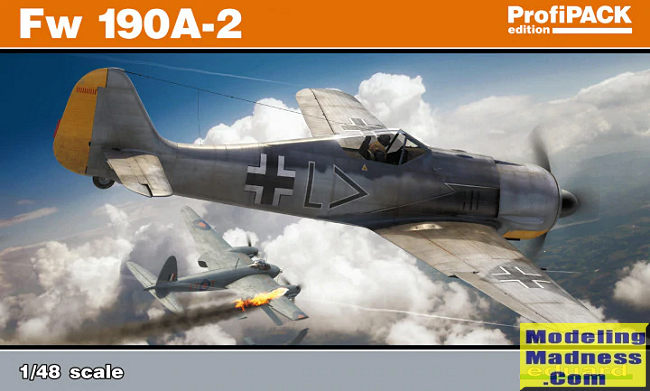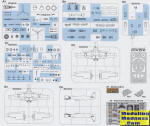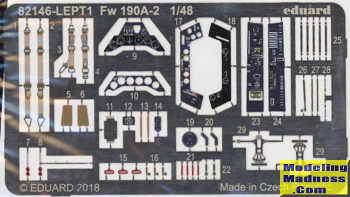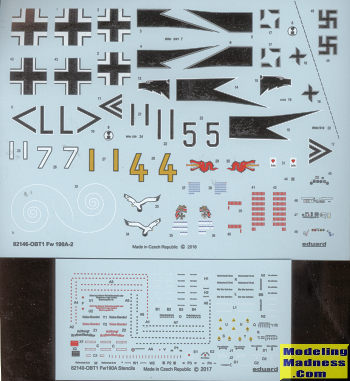
| KIT #: | 82146 |
| PRICE: | $49.99 SRP |
| DECALS: | Five options |
| REVIEWER: | Scott Van Aken |
| NOTES: | 2018 release. Profipack Edition |

| HISTORY |
The introduction of the BMW 801 C-2 resulted in the Fw 190 A-2 model, first introduced in October 1941. As part of this upgrade, a modification to the exhaust system devised by III./JG 26's Technical Officer ("T.O.") Rolf Schrödeter was added. There were 13 exhausts for the 14 cylinders; eight of these were grouped to exit, four on each side, along the forward fuselage, just above the leading edge of the wing; under the forward center section, between the undercarriage bays were five exhaust stacks, with cylinders 9 and 10 sharing a common pipe. To quickly implement the fix, it was found that the re-routing could be done easily in Gruppe workshops. The reduction in temperature affecting the bottom cylinder went a long way to solving the problem of overheating and engine fires that plagued the initial production aircraft. The addition of new ventilation slots on the side of the fuselage further aided cooling, and with the widespread availability of the A-2 in the spring of 1942, the overheating problems were greatly reduced.
The A-2 wing weaponry was updated, with the two wing root-mounted 7.92 mm (.312 in) MG 17s being replaced by 20 mm MG 151/20E cannon. With the introduction of the new cannon, the Revi C12/C gunsight was upgraded to the new C12/D model. The introduction of the A-2 marked a shift in air supremacy from the British, with their Spitfire Mk V, to the Germans. German production records make no real distinction between A-2s and A-3s, which were very similar aircraft: the total combined production was 910 airframes between October 1941 and August 1942. In addition to Focke-Wulf and AGO, a new subcontractor, Arado, built A-2s and A-3s at Warnemünde.
| THE KIT |
 It was only a matter of time before Eduard decided to produce
a series of 'short nose' FW-190As and so they did, having done most of them save
the A-1 and that may well just be a matter of time. This is the A-2 version that
has the somewhat shorter fuselage of the early versions. It is free from all the
fussy bits of the first round of 190A kits, which most of us appreciate. All the
open panel bits not in these kits are available as aftermarket if you have to
have them.
It was only a matter of time before Eduard decided to produce
a series of 'short nose' FW-190As and so they did, having done most of them save
the A-1 and that may well just be a matter of time. This is the A-2 version that
has the somewhat shorter fuselage of the early versions. It is free from all the
fussy bits of the first round of 190A kits, which most of us appreciate. All the
open panel bits not in these kits are available as aftermarket if you have to
have them.
Apparently this kit is still a bit on the fiddly side and once can tell that when looking over the instructions. However, reports from those who have built this kit for the first time are positive in terms of fit so I picked this one up. It isn't like I don't have any other 190A-s in this scale, but I wanted to give this a go on my own. If you look at the sprue layout, there are multiples of many parts (props, wheel wells, drop tanks and so on), but this is standard Eduard where they include all the bits for all variants in each kit.
 This is a Profipack kit
which includes a color photo etch fret. Much of this photo etch is used for the interior. But the
190 is a plane with a very small cockpit and save for the seat, not really all
that much can be seen there. However, for the 190, the seat really needs belts
for the seat and that is included. Also nice color side consoles and instrument
panel. Flat plastic alternatives are included in the kit so you can use these
without having to grind away detail.
This is a Profipack kit
which includes a color photo etch fret. Much of this photo etch is used for the interior. But the
190 is a plane with a very small cockpit and save for the seat, not really all
that much can be seen there. However, for the 190, the seat really needs belts
for the seat and that is included. Also nice color side consoles and instrument
panel. Flat plastic alternatives are included in the kit so you can use these
without having to grind away detail.
The engine is just the front face, which is fine as once the prop and fan are installed you won't see it. Wheel wells and the rear well/wing spar are separate items with a considerable number of items to go in the well. Unfortunately, it is designed such that you have to install the inner wing guns prior to closing the wing halves, making it easy to snap off the barrels while cleaning the seams or installing the wing.
 Just to add to fiddly, there are two upper and one lower
cowling panel to install and this kit has a separate instrument panel anti-glare
section. All the control surfaces are separate and shown modeled in the neutral
position. Landing gear is well done with separate hubs and wheels to aid
painting. Note that these 190s have inner gear doors and in fact, these were
used into the A-6 production before they were removed. Some units removed them
in the field so check photos. The lone resin bits included in this kit are for
these doors. Since there are doors on the plastic sprues as well, I have to
assume those on the A-2 were different from later models. Prop blades are one piece with the two piece hub.
The back of the spinner is the engine fan. You are provided two canopies to use
with one for the closed and one for the open option.
Just to add to fiddly, there are two upper and one lower
cowling panel to install and this kit has a separate instrument panel anti-glare
section. All the control surfaces are separate and shown modeled in the neutral
position. Landing gear is well done with separate hubs and wheels to aid
painting. Note that these 190s have inner gear doors and in fact, these were
used into the A-6 production before they were removed. Some units removed them
in the field so check photos. The lone resin bits included in this kit are for
these doors. Since there are doors on the plastic sprues as well, I have to
assume those on the A-2 were different from later models. Prop blades are one piece with the two piece hub.
The back of the spinner is the engine fan. You are provided two canopies to use
with one for the closed and one for the open option.
Instructions are the usual color booklet with well drawn construction steps and Gunze paint references. There are five markings options, all of them in RLM 74/75/76 with mottling of various densities. You can see these in the illustration below. Typical of aircraft on the Channel Front at the time, they all have yellow lower cowlings with most also having yellow rudders. Decals are nicely printed and you are provided a full stencil suite.

| CONCLUSIONS |
So now you need to ask yourself if it is worth $50 retail to have the standard profipack items (etched fret, canopy masks, and additional markings) in your kit. If you don't care or like photo etch, can mask a canopy of this simplicity with tape, and plan on using aftermarket decals, then it would be a much better deal to wait for the Weekend Edition and save $20 or so. If you like all that stuff, then this is the one for you. In addition, if you want open gun bay panels, resin control surfaces, metal landing gear, and all that other stuff, then Eduard would be more than happy to make this a $100 kit by selling all those extras to you.
| REFERENCES |
https://en.wikipedia.org/wiki/List_of_Focke-Wulf_Fw_190_variants
June 2019
Copyright ModelingMadness.com. All rights reserved. If you would like your product reviewed fairly and
fairly quickly, please
contact
the editor or see other details in the
Note to
Contributors. Back to the Main Page
Back to the Review
Index Page
Back to the Previews Index Page